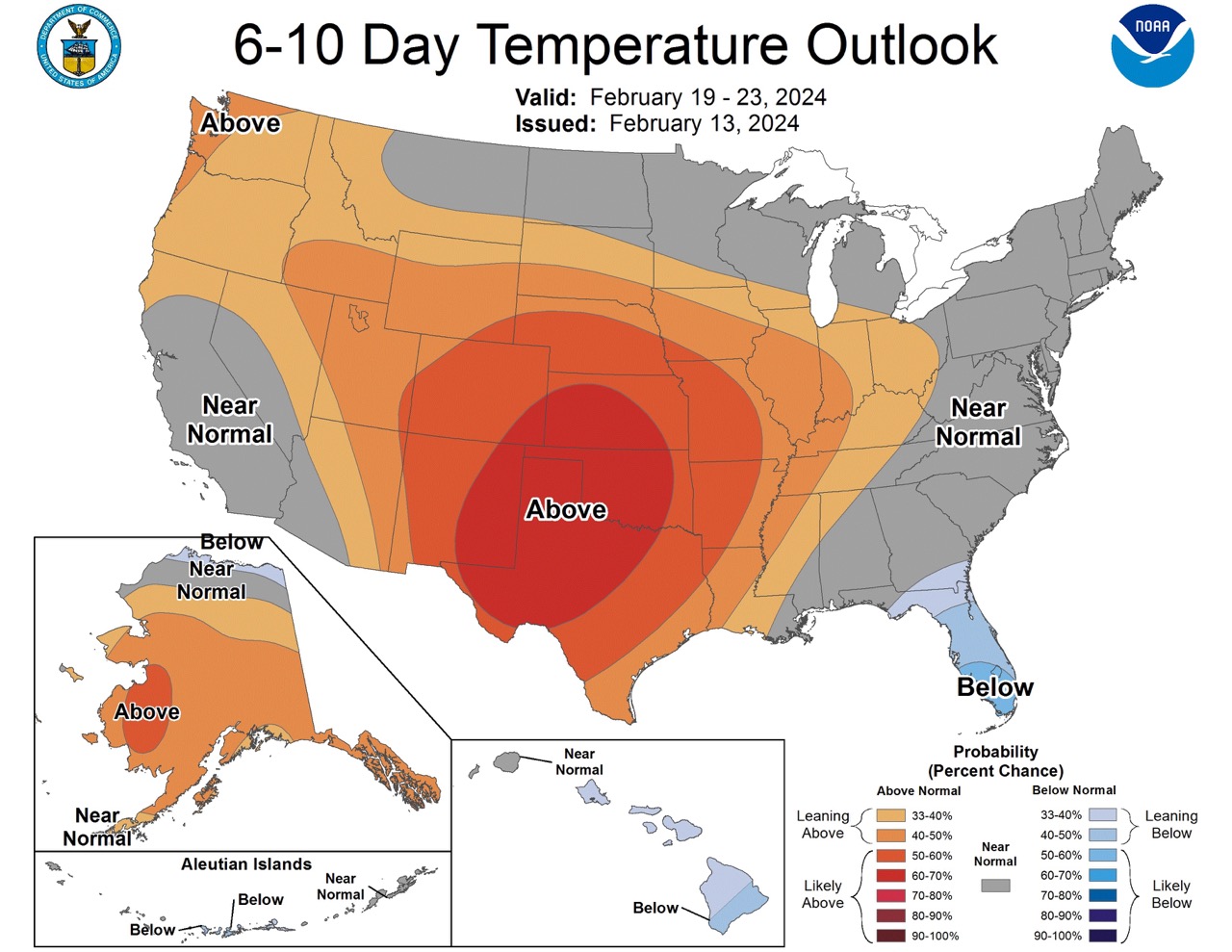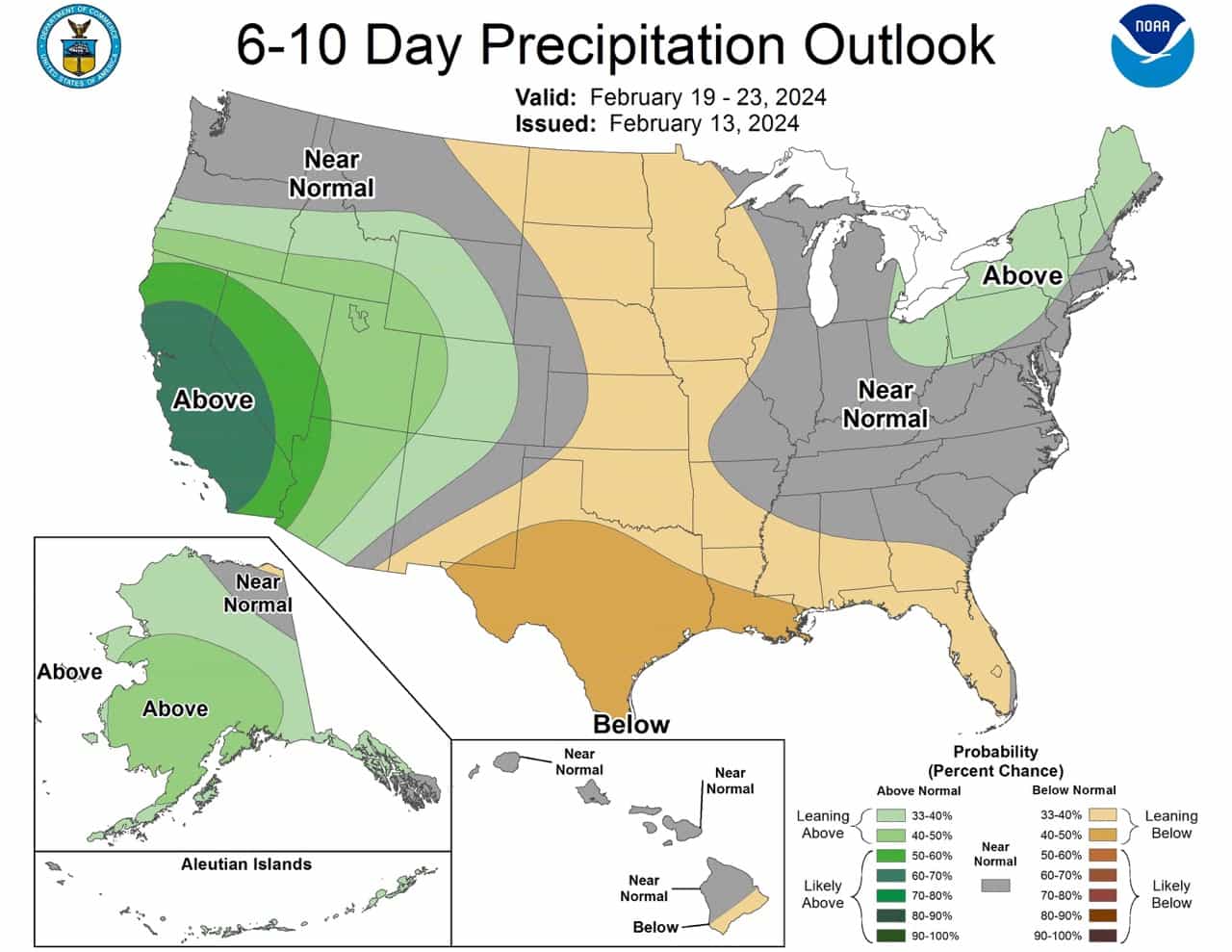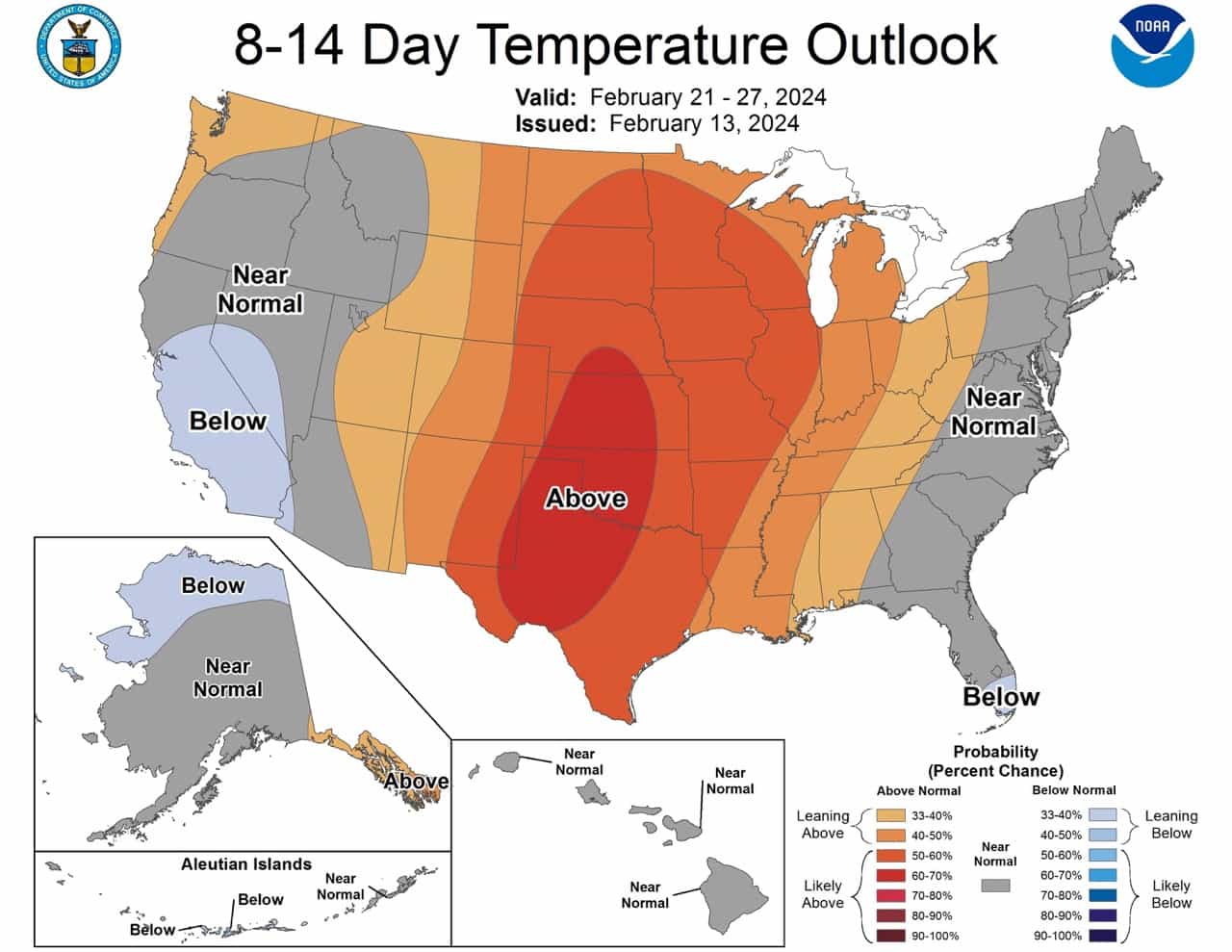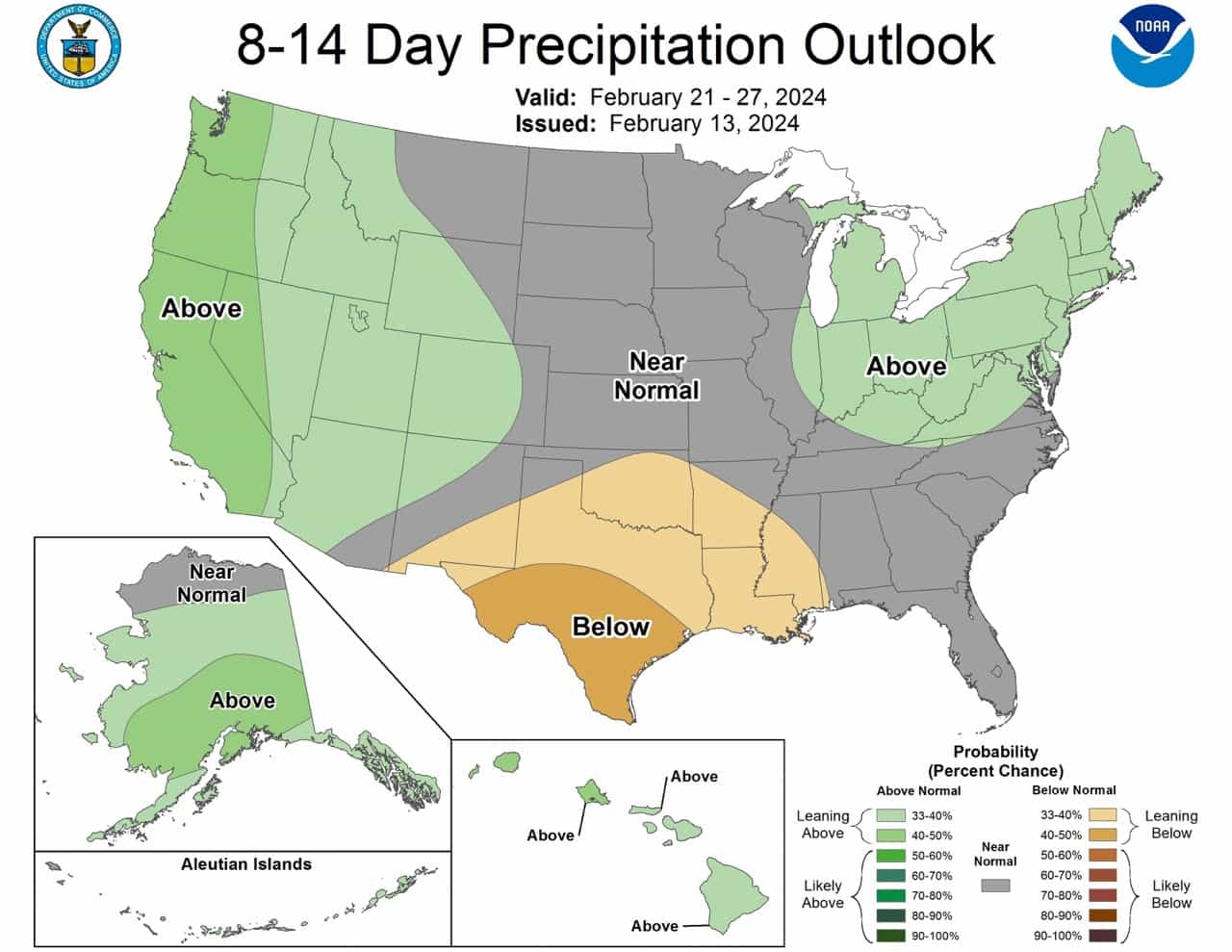
The NOAA yesterday released its outlooks for the second half of February, both 6-10 day and 8-14 day.
Here’s an AI generated summary of the text discussion for skiers. The full discussion for those familiar with meteorology jargon is further below.
6-10 Day Outlook (Feb 19 – 23, 2024):
- Where to expect snow:
- California & Southwest: High probabilities for above-normal precipitation early on suggest good snowfall potential in ski resorts in these regions.
- Northeast: Towards the end of the period, there’s a slight tilt towards above-normal precipitation, indicating potential snowfall in this area as well.
- Where snow might be limited:
- Great Plains, Mississippi Valley, Gulf Coast: Below-normal precipitation probabilities decrease the likelihood of significant snowfall in these areas.
- Hawaii: Except for the southern part of the Big Island, where below-normal precipitation probabilities are slightly enhanced, snowfall is unlikely in Hawaii.

8-14 Day Outlook (Feb 21 – 27, 2024):
- Where to expect snow:
- West, especially Pacific Northwest: Elevated probabilities for above-normal precipitation suggest good snowfall potential in ski resorts in these regions.
- Ohio Valley & Northeast: Shortwave disturbance may enhance precipitation, indicating potential snowfall during this period as well.
- Where snow might be limited:
- East Coast: Near-normal temperatures with a slight tilt towards below-normal in south Florida might affect snow quality and accumulation in ski resorts in these areas.
- Southern Plains & Lower Mississippi Valley: Increased chances for below-normal precipitation decrease the likelihood of significant snowfall in these regions.
- Alaska: Although initially, above-normal temperatures are expected, as troughing shifts eastward, trending cooler might affect snow conditions in ski resorts in Alaska.
- Hawaii: Slightly elevated chances for above-normal precipitation might lead to limited snowfall, especially in higher elevations.

Prognostic Discussion for 6 to 10 and 8 to 14 day outlooks NWS Climate Prediction Center College Park, MD 300 PM EST Tue February 13 2024 6-10 DAY OUTLOOK FOR FEB 19 - 23 2024 A transient 500-hPa geopotential height pattern is forecast across North America during the 6-10 day period. Initially, anomalous troughing is predicted off the West Coast of the CONUS and across southeastern Canada and the north Atlantic, with a shortwave feature forecast to be moving off the coast of the southeastern U.S. The West Coast trough is forecast to weaken by the end of the period, with the 0z ECMWF, GEFS, and Canadian ensembles depicting more ridging in the West by day-10. Models reload the troughing in the East toward the end of the period, with the 0z ECMWF ensemble being the most robust with this scenario. Given the model differences and transient pattern, near-normal 500-hPa heights are favored across much of the CONUS in today’s manual blend, with larger negative height anomalies predicted near the West Coast and northern New England. Above-normal heights are favored across the south-central CONUS as ridging builds upstream of the trough. Across Alaska, troughing expanding across the Bering Sea favors an erosion of the ridge initially predicted over the Mainland. Positive height anomalies are predicted across much of Mainland and Southeast Alaska underneath this initial ridging, with negative height anomalies forecast over the Aleutians and extreme western Mainland Alaska. Near- to above-normal heights are predicted across Hawaii. Dynamical models continue to favor above-normal temperatures over much of the CONUS during the period, although teleconnection analysis with the negative height anomaly center over the north Atlantic favors below-normal temperatures across the northern U.S. Compared to yesterday, probabilities of above-normal temperatures are increased, with the highest chances (greater than 60 percent) highlighted over parts of the Central and Southern Plains. Near-normal temperatures are favored along the Northern Tier and along the Eastern Seaboard consistent with the uncalibrated 0z ECMWF and Canadian ensembles, as well as to maintain continuity with yesterday’s cooler forecast. Both the GEFS and ECMWF reforecast tools support increased chances for below-normal temperatures across the Florida Peninsula. Uncalibrated guidance generally favors below-normal temperatures across the Southwest, with the GEFS and ECMWF reforecast tools favoring above-normal temperatures likely tied to enhanced onshore flow. Given this discrepancy, near-normal temperatures are favored for the Southwest, with probabilities for above-normal temperatures increased across the Northwest, consistent with higher probabilities for above-normal temperatures in the reforecast tools. Elevated chances for above-normal temperatures are predicted for much of Alaska as upstream troughing favors enhanced southerly flow across the state. Probabilities for below-normal temperatures are slightly increased across most of Hawaii, consistent with the consolidation forecast tool. Early in the period, strong onshore flow is forecast across California and adjacent parts of the Southwest, favoring high probabilities for above-normal precipitation over these areas. Enhanced northerly flow in the wake of troughing off the Southeast coast combined with ridging developing over central CONUS favors increased chances for below-normal precipitation across the Great Plains, Mississippi Valley, and near the Gulf of Mexico coast. Surface low pressure may develop across the Northeast or off the coast toward the end of the period as troughing potentially reloads across the region. The 0z GEFS is more robust with this system, with the 0z ECMWF ensemble depicting most of the associated moisture offshore. Given the pattern, a slight tilt in the odds toward above-normal precipitation is highlighted over parts of the Ohio Valley and Northeast. Troughing and enhanced southerly flow favor elevated probabilities of above-normal precipitation across most of Alaska. Weak ridging to the south of Hawaii favors elevated chances for near-normal precipitation across much of the state, with the exception of the southern part of the Big Island where below-normal precipitation probabilities are slightly enhanced. The official 6-10 day 500-hPa height blend consists of 35% of Today's 0z GFS Ensemble Mean centered on Day 8, 35% of Today's 0z European Ensemble Mean centered on Day 8, and 30% of Today's 0z Canadian Ensemble Mean centered on Day 8 FORECAST CONFIDENCE FOR THE 6-10 DAY PERIOD: Average, 3 out of 5, due to improved model agreement compared to yesterday, but still some uncertainty given the transient mid-level pattern the degree of northward and eastward expansion of the above-normal temperature probabilities over the CONUS. 8-14 DAY OUTLOOK FOR FEB 21 - 27 2024 The longwave 500-hPa geopotential height pattern is forecast to continue shifting eastward during week-2. The troughing across Alaska is forecast to build into the western CONUS, with a trend toward a more zonal mid-level flow pattern favored east of the Rockies, with some hints of ridging developing in the East by the end of the period. The manual 500-hPa height blend for week-2 continues to depict near-normal heights for most of the CONUS, with slightly below-normal heights favored across parts of the Pacific Northwest and Upper Great Lakes. Slightly above-normal heights are indicated over south Texas. Negative height anomalies are forecast across Alaska underneath troughing moving across the state, with near-normal heights favored across Hawaii. As in the 6-10 day forecast, dynamical models continue to favor anomalous warmth across much of the CONUS during week-2, especially across the Great Plains into parts of the Midwest. As a result, above-normal temperature probabilities are increased over much of the central CONUS. There is some uncertainty regarding the eastward expansion of above-normal temperatures as dynamical models suggest a reloading of the trough around the middle of the period which would favor a break in any potential warming, with the uncalibrated 0z ECMWF ensemble favoring increased odds for below-normal temperatures along the Eastern Seaboard for the period as a whole. Therefore, near-normal temperatures are highlighted across the East, with a slight tilt toward enhanced probabilities for below-normal temperatures across south Florida. Troughing is forecast to gradually shift eastward from Alaska, with negative mid-level height anomalies spreading into the western CONUS by the end of the period favoring elevated probabilities for near- to below-normal temperatures over parts of the West. At the outset of week-2, above-normal temperatures are favored across most of Alaska. However, as the troughing shifts more east and the northerly component of the mid-level flow increases, a trend toward cooler temperatures is forecast. For week-2 as a whole, near-normal temperatures are favored for the central and southern Mainland, with increased probabilities for above- (below-) normal temperatures highlighted across Southeast Alaska (northern Mainland). Near-normal temperatures are predicted across Hawaii. Precipitation chances are forecast to diminish across the Southwest as the week-2 period progresses, although onshore flow is forecast to increase across the Pacific Northwest especially as troughing increases later in the period. This results in elevated probabilities for above-normal precipitation over much of the West from the Pacific Coast to the Rockies. A weaker mid-level flow pattern is favored downstream, although a shortwave disturbance may enhance precipitation over parts of the Ohio Valley and Northeast around the middle of the period, tilting the odds toward above-normal for the period as a whole. Across the Southern Plains and Lower Mississippi Valley, below-normal precipitation probabilities are increased further displaced from the mean storm track to the north. Elevated chances for above-normal precipitation are favored for most of Alaska due to increased southerly flow, with near-normal precipitation chances elevated north of the Brooks Range. Weak troughing is forecast to move closer to Hawaii compared to the 6-10 day period favoring slightly elevated chances for above-normal precipitation across the state. The official 8-14 day 500-hPa height blend consists of: 40% of Today's 0z GFS Ensemble Mean centered on Day 11, 40% of Today's 0z European Ensemble Mean centered on Day 11, and 20% of Today's 0z Canadian Ensemble Mean centered on Day 11 FORECAST CONFIDENCE FOR THE 8-14 DAY PERIOD: Average, 3 out of 5, due to increasing confidence regarding a warmer pattern developing across the central CONUS, with more uncertainty across the East. FORECASTER: Thomas Collow
